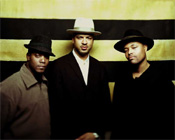| |
Jason
Moran & The Bandwagon
Antwerp BELGIUM, 7 November 2003
by Mwanji Ezana
December 2003
 "We
are the Bandwagon, picking up passengers and dropping them off, lost,
leaving them to find their own way home." That's how Jason Moran
described his trio, mid-way through the one-set, 90-minute concert.
The actual introduction was a kind of (extremely loud) hip-hop cut'n'paste
take on the traditional spoken band presentation. A pre-recorded message
gave out the names of the musicians, followed by what were presumably
samples of their own playing. So you'd hear "Nasheet Waits!"
followed by drum rolls. "We
are the Bandwagon, picking up passengers and dropping them off, lost,
leaving them to find their own way home." That's how Jason Moran
described his trio, mid-way through the one-set, 90-minute concert.
The actual introduction was a kind of (extremely loud) hip-hop cut'n'paste
take on the traditional spoken band presentation. A pre-recorded message
gave out the names of the musicians, followed by what were presumably
samples of their own playing. So you'd hear "Nasheet Waits!"
followed by drum rolls.
I'd previously heard very little of Moran, apart from a few live mp3s
downloaded from his website and his sideman appearance on Greg Osby's
Banned in NY, but the recent flurry of positive CD and concert
reviews had whetted my appetite. This was actually the first time
the Bandwagon had played in Belgium as a trio, even though last summer
they played here with Sam Rivers. Parenthetically, I had assumed that
the hat he wears in promotional photos was precisely that: a promotional
device to project retro/pomo cool, but apparently Moran wears the
hat in real life, too. He had left his red chair at home, however.
After the intro, they roared into the first piece. Beginning with
free playing, Moran laying out clusters so thick he was almost playing
with his palms, the trio then proceeded through a veritable whirlwind
of rhythmic feels before climaxing in a sort of uptempo bluesy bop
for a loud and viscerally exciting piano solo. Reaching near sensory
overload, I felt like I was in that Indiana Jones mine shaft, hanging
on to the chariot for dear life: a great beginning!
The second song began with the piano alone: crashing dissonance settled
into a more straight-forward ballad. Interestingly, Moran approaches
ballads in more of a classical/pop way than in a jazz way. Then Tarus
Mateen, slumped (almost crumpled) over in his chair in a cool John
Lee Hooker kind of way, came in with a fast, oddly disconnected bass
solo. While Moran (and the trio, overall) successfully jumped from
one thing to the next at a moment's notice, I had trouble understanding
where Mateen's solo interventions were coming from, especially during
the first part of the concert.
A drum solo anchored by the middle tom (for some inexplicable reason,
every element of Waits' kit was miked, making him far too loud) opened
the following number. A bouncy theme slowed down to a much sparser
midtempo swing/blues. Moran gave a piano cue to go into a more aggressive,
funky groove, but by this time it was obvious that no one atmosphere
would survive intact very long. Indeed, in the time it took me to
jot down what was going on, they had changed direction. Throughout
the concert, there were times where you could have danced, but only
for a few steps before the groove had dissipated into something else.
The piece ended with a fragment of a ballad that first sounded like
Grieg's "At Dawn" from Peer Gynt, then went into jazz chords.
Henry Threadgill's "Too Much Sugar for a Dime" was announced,
and led to a very nice intermingling of free playing and a motif drawn
from the theme. A quite opposite method was chosen for the next number,
as free playing over a fast ostinato vamp gave way to the pretty,
Brazilian melody of "Estate" (I think), like the sea withdrawing
at low tide to reveal a completely unexpected landscape underneath.
At the end, Moran amused himself by playing a simplified version of
the melody in the very low register of the piano.
Moran's "Out Front" was a complete joy, a marvelously rhythmic
combination of stride in the left hand and free lines in the right.
Later, Mateen introduced a slow, chugging blues shuffle which was
taken up by the rest of the band, only to be accelerated into an almost-boogaloo.
Then came "Straight Outta Istanbul", which has been an attention-grabber
in most articles I've read. For those who don't know, they play over
the recording of a telephone call in Turkish. It's highly impressive
how they follow the "melody" of the female voice. After
traditionally-notated scores, graphic scores, here comes the audio
score? They played through the recording a number of times, breaking
away when it went into a 20-second loop. Interest was renewed when
the recording went into a one bar loop, because it took on a rhythmic,
hip hop-ish character, rather than a melodic one. In fact, Moran's
playing was peppered with wide-ranging almost-quotes, which again
abstractly alluded to hip-hop cut'n'pasting.
The quiet solo piano that followed clearly displayed Moran's (perhaps
too heavy) attraction for sudden sforzandos and quick dissonances,
all the while sustaining a sweet melody. The last performance was
notable for its hard hip-hop beat, which was intermittently deepened
by the piano's lower register, leading into an amusingly over-the-top
drum-bashing climax. As Moran announced the end of the concert, I
was surprised: time had flown by, the music had not dragged once.
|
|
|
|
|

